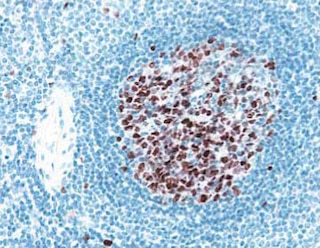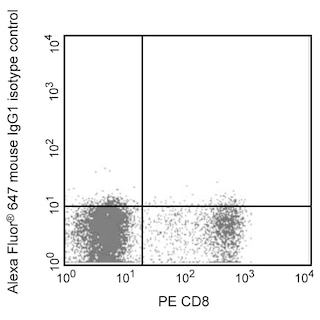Old Browser
This page has been recently translated and is available in French now.
Looks like you're visiting us from {countryName}.
Would you like to stay on the current country site or be switched to your country?






Flow cytometric analysis of FoxP2 expression in human RPMI-8226. Cells from the human RPMI-8226 (Plasmacytoma, ATCC CCL-155) cell line were fixed in BD Cytofix™ Fixation Buffer (Cat. No. 554655), permeabilized with BD Phosflow™ Perm Buffer III (Cat. No. 558050) and stained with matching concentrations of either Alexa Fluor® 647 Mouse IgG1, κ Isotype Control (Cat. No. 557732; dashed line histogram) or Alexa Fluor® 647 Mouse Anti-FoxP2 antibody (Cat. No. 564463; solid line histogram). The fluorescence histograms were derived from gated events with the forward and side light-scatter characteristics of intact RPMI-8226 cells. Flow cytometric analysis was performed using a BD LSRFortessa™ Flow Cytometer System.

Image analysis of FoxP2 expression by Purkinje cells within the mouse cerebellum. Following antigen retrieval with BD Retrievagen A (Cat. No. 550524), sections prepared from formalin-fixed and paraffin-embedded mouse cerebellum were stained with matching concentrations of Alexa Fluor® 647 Mouse IgG1, κ Isotype Control (Upper Panel) or Alexa Fluor® 647 Mouse Anti-FoxP2 antibody (Lower Panel; Pseudocolored Red). The tissues were counterstained with Alexa Fluor® 488 Mouse Anti-β-Tubulin, Class III antibody (Cat. No. 560338; Pseudocolored Green) and Hoechst 33342 Solution (Cat. No. 561908; Pseudocolored Blue). The Purkinje cell nuclei stained positively for the expression of FoxP2. Images were analyzed using a BD Pathway™ 435 High-Content Bioimager System and merged using BD Attovision™ Software.


BD Pharmingen™ Alexa Fluor® 647 Mouse Anti-FoxP2

BD Pharmingen™ Alexa Fluor® 647 Mouse Anti-FoxP2

Regulatory Status Legend
Any use of products other than the permitted use without the express written authorization of Becton, Dickinson and Company is strictly prohibited.
Preparation And Storage
Product Notices
- Since applications vary, each investigator should titrate the reagent to obtain optimal results.
- Please refer to www.bdbiosciences.com/us/s/resources for technical protocols.
- An isotype control should be used at the same concentration as the antibody of interest.
- The Alexa Fluor®, Pacific Blue™, and Cascade Blue® dye antibody conjugates in this product are sold under license from Molecular Probes, Inc. for research use only, excluding use in combination with microarrays, or as analyte specific reagents. The Alexa Fluor® dyes (except for Alexa Fluor® 430), Pacific Blue™ dye, and Cascade Blue® dye are covered by pending and issued patents.
- Alexa Fluor® is a registered trademark of Molecular Probes, Inc., Eugene, OR.
- Alexa Fluor® 647 fluorochrome emission is collected at the same instrument settings as for allophycocyanin (APC).
- Caution: Sodium azide yields highly toxic hydrazoic acid under acidic conditions. Dilute azide compounds in running water before discarding to avoid accumulation of potentially explosive deposits in plumbing.
- For fluorochrome spectra and suitable instrument settings, please refer to our Multicolor Flow Cytometry web page at www.bdbiosciences.com/colors.
Companion Products






The FOXP2-73A/8 monoclonal antibody specifically binds to Forkhead box protein P2 (FoxP2). FoxP2 is also known as TNRC10 (Trinucleotide repeat-containing gene 10 protein), CAGH44 (CAG repeat protein 44), and SPCH1 (Speech and Language Disorder 1). FoxP2 is a member of the forkhead/winged-helix (FOX) family of transcription factors. Normal FOXP2 gene expression is associated with the proper development of cardiovascular, gastrointestinal, and neural tissues including the speech and language regions of the brain. FoxP2 protein has been detected in most normal tissues including epithelial and endothelial cells but not cells of hematopoietic origin. Although not normally detected in lymphocytes and plasma cells, FoxP2 protein was reportedly expressed in a small fraction of plasma cells from reactive human tonsils. Aberrant FOXP2 gene expression has been associated with abnormal plasma cell generation and may play a role in multiple myeloma and other hematological malignancies. The FOXP2-73A/8 antibody detects human and mouse FoxP2 and does not crossreact with other members of the FOXP family (FoxP1, FoxP3 or FoxP4).
Development References (2)
-
Campbell AJ, Lyne L, Brown PJ, et al. Aberrant expression of the neuronal transcription factor FOXP2 in neoplastic plasma cells. Br J Haematol. 2010; 149(2):221-230. (Immunogen: Immunohistochemistry, Western blot). View Reference
-
Lai CS, Fisher SE, Hurst JA, Vargha-Khadem F, Monaco AP. A forkhead-domain gene is mutated in a severe speech and language disorder. Nature. 2001; 413(6855):519-523. (Biology). View Reference
Please refer to Support Documents for Quality Certificates
Global - Refer to manufacturer's instructions for use and related User Manuals and Technical data sheets before using this products as described
Comparisons, where applicable, are made against older BD Technology, manual methods or are general performance claims. Comparisons are not made against non-BD technologies, unless otherwise noted.
For Research Use Only. Not for use in diagnostic or therapeutic procedures.
Report a Site Issue
This form is intended to help us improve our website experience. For other support, please visit our Contact Us page.